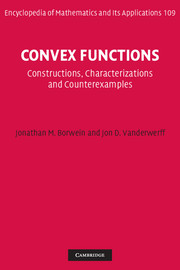Book contents
- Frontmatter
- Contents
- Preface
- 1 Why convex?
- 2 Convex functions on Euclidean spaces
- 3 Finer structure of Euclidean spaces
- 4 Convex functions on Banach spaces
- 5 Duality between smoothness and strict convexity
- 6 Further analytic topics
- 7 Barriers and Legendre functions
- 8 Convex functions and classifications of Banach spaces
- 9 Monotone operators and the Fitzpatrick function
- 10 Further remarks and notes
- List of symbols
- References
- Index
4 - Convex functions on Banach spaces
Published online by Cambridge University Press: 07 September 2011
- Frontmatter
- Contents
- Preface
- 1 Why convex?
- 2 Convex functions on Euclidean spaces
- 3 Finer structure of Euclidean spaces
- 4 Convex functions on Banach spaces
- 5 Duality between smoothness and strict convexity
- 6 Further analytic topics
- 7 Barriers and Legendre functions
- 8 Convex functions and classifications of Banach spaces
- 9 Monotone operators and the Fitzpatrick function
- 10 Further remarks and notes
- List of symbols
- References
- Index
Summary
Banach contributed to the theory of orthogonal series and made innovations in the theory of measure and integration, but his most important contribution was in functional analysis. Of his published works, his Théorie des opérations linéaires (1932; “Theory of Linear Operations”) is the most important. Banach and his coworkers summarized the previously developed concepts and theorems of functional analysis and integrated them into a comprehensive system. Banach himself introduced the concept of [complete] normed linear spaces, which are now known as Banach spaces. He also proved several fundamental theorems in the field, and his applications of theory inspired much of the work in functional analysis for the next few decades.
(Encyclopedia Britannica)Continuity and subdifferentials
Throughout the rest of the book X denotes a normed or a Banach space. We assume familiarity with basic results and language from functional analysis, and we will often draw upon the classical spaces ℓp, c0 and others for examples. Notwithstanding, we will sketch some of the classic convexity theorems in our presentation.
We write X* for the real dual space of continuous linear functionals, and denote the unit ball and sphere by BX ≔ {x ∈ X : ∥x∥ ≤ 1} and SX ≔ {x ∈ X : ∥x∥ = 1}, respectively. We say that a subset C of X is convex if, for any x, y ∈ C and any λ ∈ [0, 1], λx + (1 - λ)y ∈ C.
- Type
- Chapter
- Information
- Convex FunctionsConstructions, Characterizations and Counterexamples, pp. 126 - 208Publisher: Cambridge University PressPrint publication year: 2010

